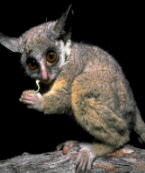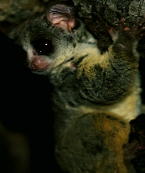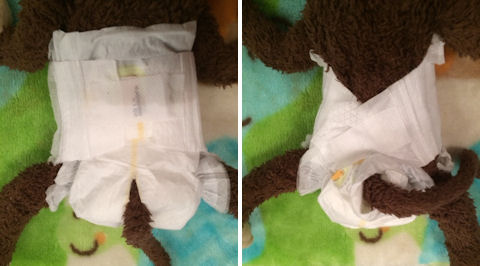While there are several species of Bushbabies, we’ll only be talking about the Lesser Bushbaby which is more commonly kept in captivity. The Lesser Bushbaby, also called Senegal Bushbaby (Galago Senegalensis), is a monkey that feeds at night mainly on insects which they locate by sound. Besides large ears, they also have large eyes for night vision. The hinds legs are used for jumping (like a kangaroo), they are longer and more powerful than their front legs. They can jump 10 to 16 feet in one single leap. Here you’ll find more information about keeping Lesser Bushbabies in Captivity.
 |
 |
| Lesser Bushbaby Care Sheets
|
Bushbaby Species:
Allen’s bushbaby (Galago alleni) |
How to diaper a monkey
March 1, 2015 5:45 am

Amongst primate owners, the most commonly known method of diapering is the tail hole method but more and more primate owners are switching over to the tail wrap method. Since I’ve used both methods myself and don’t really have a particular preference, I reached out to other primate owners to find out why they prefer one method over the other. Before we go into more details, I’ve recorded a short video to demonstrate the difference between both methods. After that we’ll talk about diaper covers, different diaper brands, and what monkey parents are doing to prevent diaper rash.
Posted in baboon, bush baby, capuchin, chimpanzee, gibbon, macaque, marmoset, owl monkeys, primate care, savanna monkey, squirrel monkeys, tamarin
Arabic Gum
December 30, 2011 6:13 am
While there are several species of Bushbabies, we’ll only be talking about the Lesser Bushbaby which is more commonly kept in captivity. The Lesser Bushbaby, more...
Posted in bush baby, enrichment, feeding, marmoset
The feeding of Primates
December 29, 2011 8:34 pm
By Ivan Crab
During recent years, the feeding of PRIMATES has undergone significant changes, as more has been discovered about their nutritional needs. The pets market of today provide different “monkey pellets” , pelleted diets they are usually well balanced but they can not by given at the expense of a varied diet.
It is no coincidence that when breeding began in earnest during the 1950s, it was the OLD WORLD species which reproduced most successfully in collections. This is because MONKEYS such as the MACACA species were best-suited to thrive and breed on a diet composed of little more than vegetables and fruits.
The needs of other species are more complex. Certainly in captivity they thrive when offered a diet which contains a relatively high proportion of vegetables and fruit. more...
Posted in baboon, bush baby, capuchin, feeding, gibbon, lemur, macaque, marmoset, owl monkeys, squirrel monkeys, tamarin